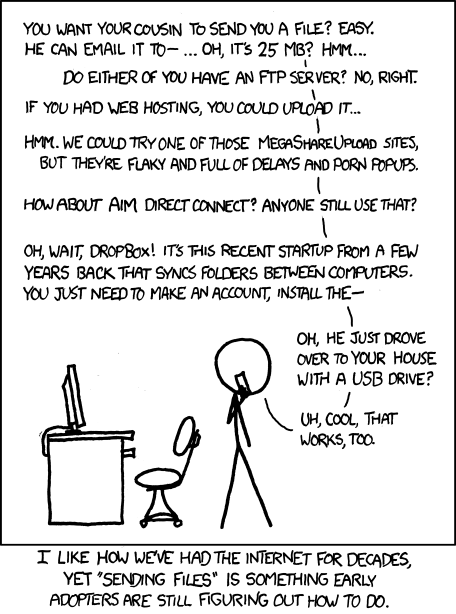DropShare is the answer to the age-old question of File Transfer:
Similar services include
A few different clients are avaible.
With the web-client you can drag-n-drop or use the normal upload/download.
Usage
dropshare /path/to/file.ext
# Example - share your public ssh key with someone
dropshare ~/.ssh/id_rsa.pub
Example Output
Your file, Sir! (or Ma'am):
http://dropsha.re/#foHsCQA
wget 'http://api.dropsha.re/files/foHsCQA/[email protected]'
curl 'http://api.dropsha.re/files/foHsCQA' -o '[email protected]'
sudo wget 'https://raw.github.com/SpotterRF/dropshare/master/clients/dropshare.py' -O '/usr/local/bin/dropshare'
sudo chmod a+x '/usr/local/bin/dropshare'
sudo wget 'https://raw.github.com/SpotterRF/dropshare/master/clients/dropshare.sh' -O '/usr/local/bin/dropshare'
sudo chmod a+x '/usr/local/bin/dropshare'
If you're interested in consulting or setup to run DropShare on your private network at your Home Office, or Business please contact [email protected].
If you don't want to customize it at all you can install it via npm
- Download NodeJS
npm install -g dropsharedropshare-server- The database will be in
dropshare/server/lib/db/db.json
But for production use with a real database
-
Install NodeJS: Linux Binary | Linux Source | OS X | Windows.
-
Install
redis. See Appendix (below) for installing redis on OS X.sudo apt-get install redis-server
brew install redis launchctl load -w ~/Library/LaunchAgents/io.redis.redis-server.plist
-
Install
jade, Pakmanager,less, and some other fun things.npm install -g jade less pakmanager uglify-js
-
Install dropshare in your webapps directory (I use connect-vhoster)
git clone git://github.com/SpotterRF/dropshare.git dropshare.example.com
-
Copy
config.default.jstoconfig.js, and customize any server settings you would like.cd dropshare.example.com rsync -a config.default.js config.js
-
Download dependencies and compile the static assets. (You may wish to look at
deploy.shto understand what it does)./deploy.sh # possibly needs
sudo -
Start the server. By default it runs on port 3700 (but if it's different, you'll see it).
node bin/dropshare-server.js
The server can take parameters in a few forms. If you are just running a
stand-alone server, then you can put them in the config.js file. If
you are creating a Dropshare server in code, then you can pass an object
in to the create() method exported by lib/index.js.
The parameters all have sensible defaults that should work out of the box, so you don't actually need any of them.
client: the path to the public folder for the browser interface. Defaults to./publicstorageDir: a path to a directory to store uploaded files. Defaults to./files.allowUserSpecifiedIds: if true, allow users to specify the ids that files will be stored under.
Run the tests with:
cd tests
./test.sh
The tests depend on being in the same directory as the test script, due to paths to resources and such.
Dropshare is available under the following licenses:
- MIT
- Apache 2
Copyright 2011 - 2012 Jamison Dance and AJ ONeal
brew install redis
mkdir -p ~/Library/LaunchAgents
launchctl unload -w ~/Library/LaunchAgents/io.redis.redis-server.plist 2>/dev/null || true
cp /usr/local/Cellar/redis/2.2.12/io.redis.redis-server.plist ~/Library/LaunchAgents/
launchctl load -w ~/Library/LaunchAgents/io.redis.redis-server.plist
To start redis manually:
redis-server /usr/local/etc/redis.conf
To access the server: redis-cli
sudo apt-get install redis-server # may be called just 'redis', depending on your distro
